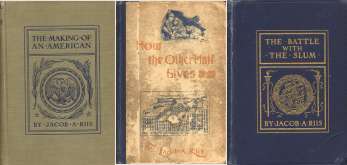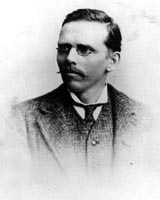Jacob August Riis was born in Denmark in 1849, and immigrated to the
United States in 1870 at the age of 21. He arrived in New York City with
no money, but like so many other immigrants, he was hoping to make his
fortune in America. Unfortunately for Riis, America was in the middle of
a depression in 1870, and many people were out of work and homeless.
Riis managed to find a few odd jobs from time to time, but was unable
to find steady work. There were many times that he didn't have enough
money for food or shelter and was forced to live on the streets. During
the winter months he couldn't sleep outside, so he had to utilize the
only option for shelter available to people at that time who had no
money - a police lodging house. They were dirty and crowded, and people
had to sleep on the bare floor, on newspapers or a plank of wood, but at
least they had a roof over their head.
After several months of hunger and homelessness Riis was in total
despair. One cold and rainy night, he sat at the river's edge and
began to contemplate suicide. After all he thought, no one would notice
and no one would care. Then, as he later wrote in his autobiography The
Making of an American (1901), a little dog who had befriended him the
day before and had followed him around ever since, "crept upon my
knees and licked my face and the love of the little beast thawed the
icicles in my heart." Well, at least the little dog cared about
him. The little dog's affection lifted his spirits enough so that he
was able to go on.
Later that night, Riis was forced by the cold to take refuge in a police
lodging house. He tried to sneak the little dog in under his coat, but
the desk sergeant saw and made him put it outside. As he slept, Riis was
robbed of a small gold locket that he had saved and treasured as a
memento from home. He complained to the desk sergeant who got very
angry, accused Riis of being a liar, and ordered one of his officers to
throw him out.
The little dog had been waiting outside the door all night. When he saw
Riis being pushed out the door by the policeman, he bit the officer on
the leg. The policeman grabbed the dog and smashed his head against the
steps.
This incident could have been the thing that finally pushed Riis over
the edge, but instead it transformed his despair into anger. He vowed
that somehow he would find a way to avenge the death of that little dog.
Soon thereafter he began writing a book he called Hard Times.
His "hard times" continued for a while, but one day his life
was changed forever when an acquaintance who ran a telegraph school told
him about a job. He said a man who ran a news agency was looking for a
"bright young fellow whom he could break in" and offered to
write a letter of introduction for him.
Riis was hired by the agency and soon demonstrated a talent for writing.
Then he acquired a camera and taught himself photography. By 1877, his
reputation had grown so that he was hired as a police reporter for the
New York Tribune and the Associated Press. His beat was Police
Headquarters on Mulberry Street, one of the worst slums in the city. In
1887, he read about the invention of the magnesium flash and he was one
of the first photographers to use flash powder. That enabled him to
photograph the tenement interiors and the streets and back alleys of the
slums at night. In 1888, Riis left the Tribune and was hired as a photo
journalist by the New York Evening Sun where he began his crusade in
earnest to publicize the plight of the poor.
Riis' work while at the Sun and his first book, How the Other Half
Lives; Studies Among the Tenements of New York, published in 1890, were
an international sensation. His evocative writing coupled with his
revealing photographs were a powerful indictment of society's
indifference to the plight of the poor.

Inside a tenement room
Riis was an advocate for the immigrant poor, the oppressed, the
exploited, and the downtrodden. He wrote that the poor were victims of
economic slavery and that they were the "victims rather than the
makers of their fate." He also believed that poverty and misfortune
were responsible for criminal behavior. He blamed much of the misery and
crime present in the slums on the greed of landlords and building
speculators. Riis called it "premeditated murder as large-scale
economic speculation." His reporting inspired shock and horror
among New York's rich and middle classes.

Bandit's Roost
His book also captured the interest of the New York Police Commissioner,
Theodore Roosevelt, who would later become governor and then the 26th
president of the United States. Riis took Roosevelt with him on his
forays into the dark corners of the city. When Roosevelt became governor
he closed down the police lodging houses, and led the fight to enact
many reforms. Roosevelt called Riis "the most useful citizen of New
York."
Riis continued to write and lecture on the problems of the poor for the
rest of his life. He wrote several other books; including Children of
the Poor (1892), Out of Mulberry Street (1898), The Battle With the Slum
(1902), Children of the Tenement (1903), and his autobiography, The
Making of an American (1901).

The Making of an American
How the Other Half Lives
The Battle with the Slum
Riis conducted "magic lantern" shows in cities all over
America, where he projected his photos onto a large screen. One
newspaper reported, "His viewers moaned, shuddered, fainted and
even talked to the photographs he projected, reacting to the slides not
as images, but as a reality that transported the New York slum world
directly into the lecture hall."
Jacob Riis has been credited with precipitating many of the reforms that
improved the living conditions of the poor during what is now known as
the Progressive Era. Health and sanitation laws were passed and
enforced. Landlords were forced to make repairs and improvements. Laws
were passed requiring modern improvements to new residential
construction. The Mulberry Bend slums were eventually razed, largely due
to his efforts. He also started the Tenement House Commission and the
Jacob A. Riis Settlement House. By the time he died in Barrie,
Massachusetts, on May 26, 1914, he was known as the "Emancipator of
the Slums."

Jacob Riis, circa 1900
His work has proven to be an invaluable resource to historians and
social scientists ever since, but many of his photographs would be lost
today if it weren't for a photographer and historian named Alexander
Alland. In 1946, he searched for and found Riis's original glass plate
negatives in the attic of the Riis family home right before it was to be
torn down. They are now part of the collection of the Museum of the City
of New York.
Riis' magnificent contributions to the betterment of living conditions
for the immigrant poor might never have happened, were it not for the
love of that little dog. He always concluded his lectures with the
declaration, "My dog did not die unavenged!" and no one will
ever disagree with that.
|








